EDU20005 - Ecobiography: Understanding Environmental Perspectives
VerifiedAdded on 2023/06/08
|7
|1651
|161
Essay
AI Summary
This essay presents an ecobiography reflecting on the author's personal experiences and their influence on their attitudes toward environmental sustainability. Beginning with childhood memories of growing up on a farm and developing a deep connection with animals, the author recounts a pivotal moment of disillusionment that led to a commitment to animal rights and environmental protection. The essay analyzes how family, teachers, and societal observations shaped the author's understanding of environmental issues, particularly biodiversity loss due to land mining and cattle farming. Ultimately, these experiences inform the author's teaching position as a socio-ecology educator, emphasizing the importance of practical learning and fostering empathy for all living beings to promote a sustainable future. This resource is available on Desklib, where students can find a wealth of study tools and past assignments.
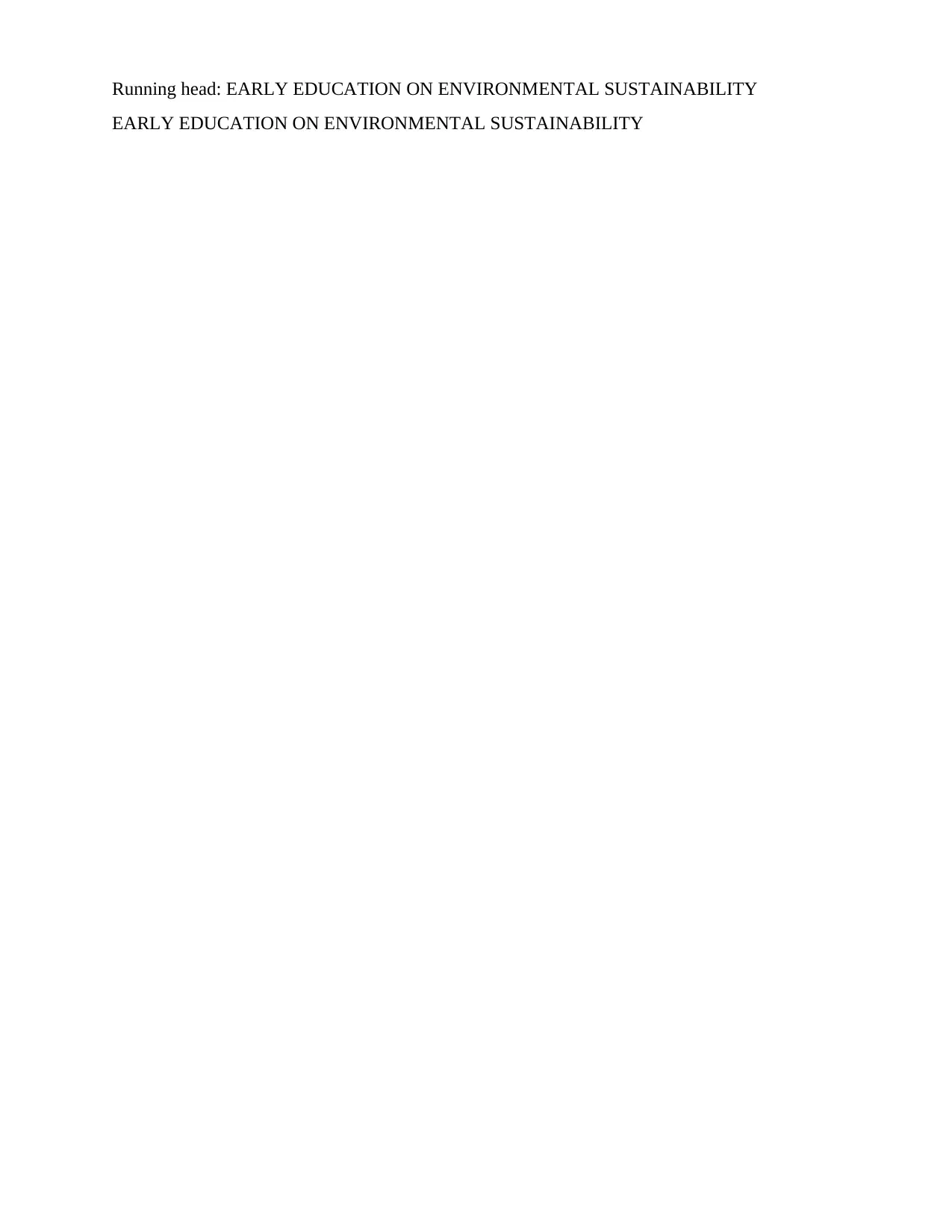
Running head: EARLY EDUCATION ON ENVIRONMENTAL SUSTAINABILITY
EARLY EDUCATION ON ENVIRONMENTAL SUSTAINABILITY
EARLY EDUCATION ON ENVIRONMENTAL SUSTAINABILITY
Paraphrase This Document
Need a fresh take? Get an instant paraphrase of this document with our AI Paraphraser
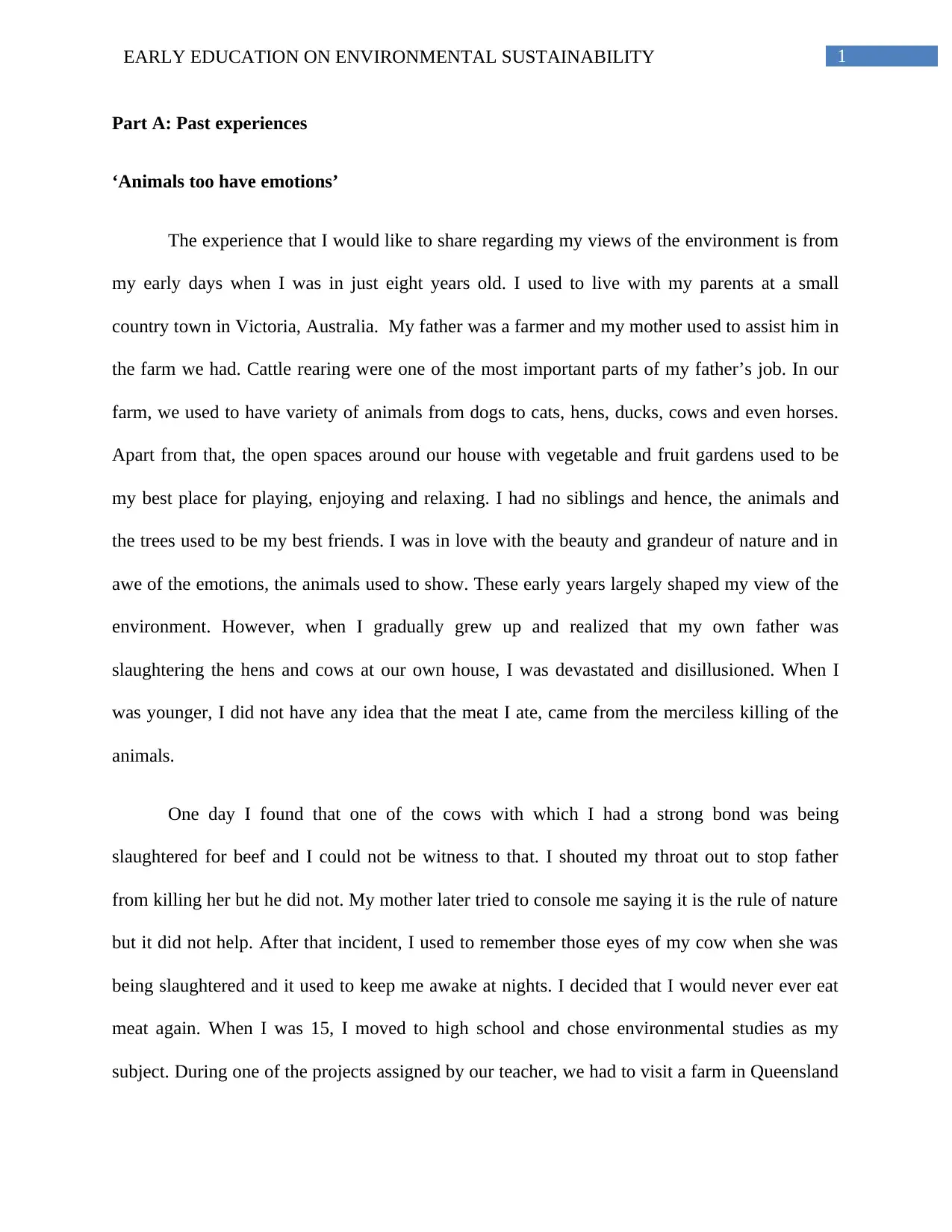
1EARLY EDUCATION ON ENVIRONMENTAL SUSTAINABILITY
Part A: Past experiences
‘Animals too have emotions’
The experience that I would like to share regarding my views of the environment is from
my early days when I was in just eight years old. I used to live with my parents at a small
country town in Victoria, Australia. My father was a farmer and my mother used to assist him in
the farm we had. Cattle rearing were one of the most important parts of my father’s job. In our
farm, we used to have variety of animals from dogs to cats, hens, ducks, cows and even horses.
Apart from that, the open spaces around our house with vegetable and fruit gardens used to be
my best place for playing, enjoying and relaxing. I had no siblings and hence, the animals and
the trees used to be my best friends. I was in love with the beauty and grandeur of nature and in
awe of the emotions, the animals used to show. These early years largely shaped my view of the
environment. However, when I gradually grew up and realized that my own father was
slaughtering the hens and cows at our own house, I was devastated and disillusioned. When I
was younger, I did not have any idea that the meat I ate, came from the merciless killing of the
animals.
One day I found that one of the cows with which I had a strong bond was being
slaughtered for beef and I could not be witness to that. I shouted my throat out to stop father
from killing her but he did not. My mother later tried to console me saying it is the rule of nature
but it did not help. After that incident, I used to remember those eyes of my cow when she was
being slaughtered and it used to keep me awake at nights. I decided that I would never ever eat
meat again. When I was 15, I moved to high school and chose environmental studies as my
subject. During one of the projects assigned by our teacher, we had to visit a farm in Queensland
Part A: Past experiences
‘Animals too have emotions’
The experience that I would like to share regarding my views of the environment is from
my early days when I was in just eight years old. I used to live with my parents at a small
country town in Victoria, Australia. My father was a farmer and my mother used to assist him in
the farm we had. Cattle rearing were one of the most important parts of my father’s job. In our
farm, we used to have variety of animals from dogs to cats, hens, ducks, cows and even horses.
Apart from that, the open spaces around our house with vegetable and fruit gardens used to be
my best place for playing, enjoying and relaxing. I had no siblings and hence, the animals and
the trees used to be my best friends. I was in love with the beauty and grandeur of nature and in
awe of the emotions, the animals used to show. These early years largely shaped my view of the
environment. However, when I gradually grew up and realized that my own father was
slaughtering the hens and cows at our own house, I was devastated and disillusioned. When I
was younger, I did not have any idea that the meat I ate, came from the merciless killing of the
animals.
One day I found that one of the cows with which I had a strong bond was being
slaughtered for beef and I could not be witness to that. I shouted my throat out to stop father
from killing her but he did not. My mother later tried to console me saying it is the rule of nature
but it did not help. After that incident, I used to remember those eyes of my cow when she was
being slaughtered and it used to keep me awake at nights. I decided that I would never ever eat
meat again. When I was 15, I moved to high school and chose environmental studies as my
subject. During one of the projects assigned by our teacher, we had to visit a farm in Queensland
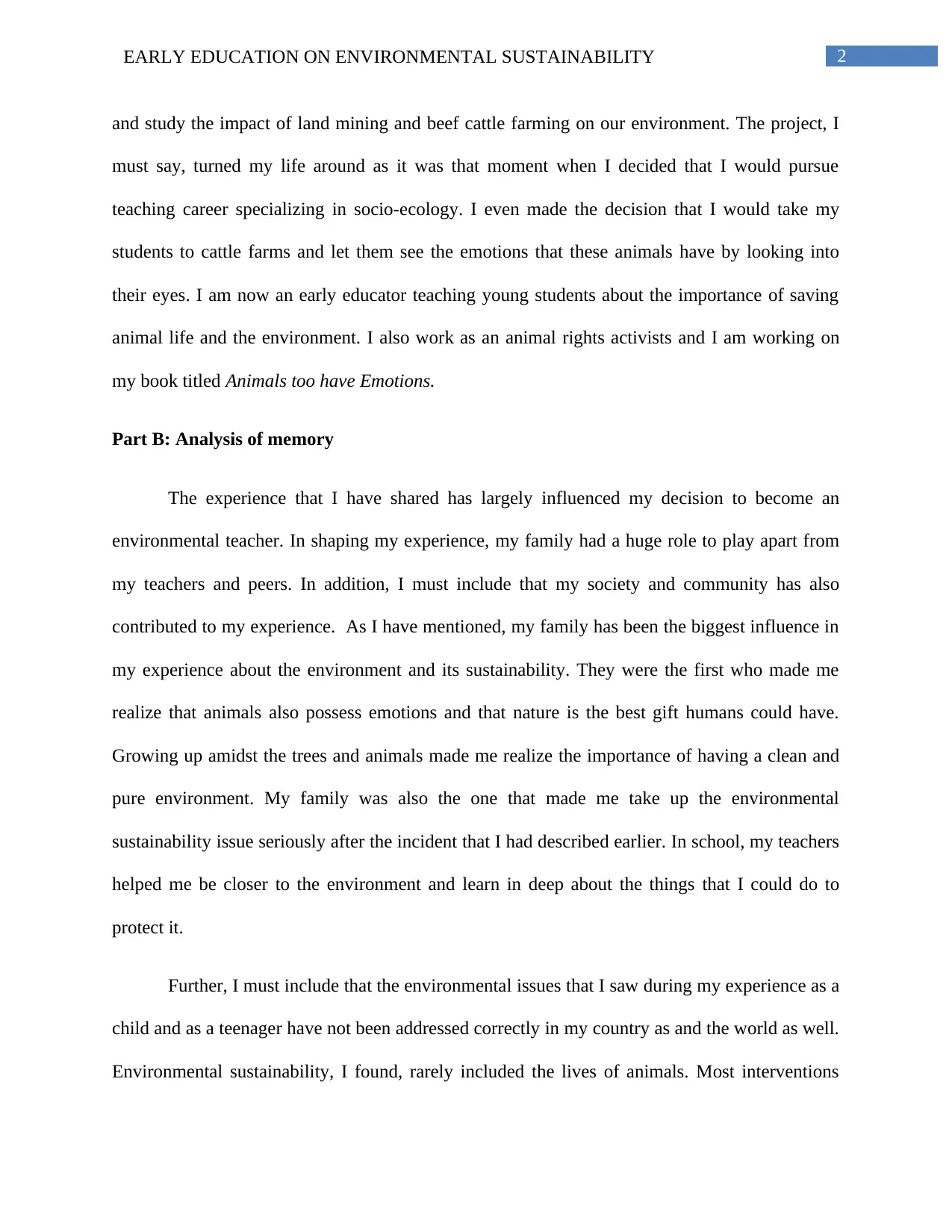
2EARLY EDUCATION ON ENVIRONMENTAL SUSTAINABILITY
and study the impact of land mining and beef cattle farming on our environment. The project, I
must say, turned my life around as it was that moment when I decided that I would pursue
teaching career specializing in socio-ecology. I even made the decision that I would take my
students to cattle farms and let them see the emotions that these animals have by looking into
their eyes. I am now an early educator teaching young students about the importance of saving
animal life and the environment. I also work as an animal rights activists and I am working on
my book titled Animals too have Emotions.
Part B: Analysis of memory
The experience that I have shared has largely influenced my decision to become an
environmental teacher. In shaping my experience, my family had a huge role to play apart from
my teachers and peers. In addition, I must include that my society and community has also
contributed to my experience. As I have mentioned, my family has been the biggest influence in
my experience about the environment and its sustainability. They were the first who made me
realize that animals also possess emotions and that nature is the best gift humans could have.
Growing up amidst the trees and animals made me realize the importance of having a clean and
pure environment. My family was also the one that made me take up the environmental
sustainability issue seriously after the incident that I had described earlier. In school, my teachers
helped me be closer to the environment and learn in deep about the things that I could do to
protect it.
Further, I must include that the environmental issues that I saw during my experience as a
child and as a teenager have not been addressed correctly in my country as and the world as well.
Environmental sustainability, I found, rarely included the lives of animals. Most interventions
and study the impact of land mining and beef cattle farming on our environment. The project, I
must say, turned my life around as it was that moment when I decided that I would pursue
teaching career specializing in socio-ecology. I even made the decision that I would take my
students to cattle farms and let them see the emotions that these animals have by looking into
their eyes. I am now an early educator teaching young students about the importance of saving
animal life and the environment. I also work as an animal rights activists and I am working on
my book titled Animals too have Emotions.
Part B: Analysis of memory
The experience that I have shared has largely influenced my decision to become an
environmental teacher. In shaping my experience, my family had a huge role to play apart from
my teachers and peers. In addition, I must include that my society and community has also
contributed to my experience. As I have mentioned, my family has been the biggest influence in
my experience about the environment and its sustainability. They were the first who made me
realize that animals also possess emotions and that nature is the best gift humans could have.
Growing up amidst the trees and animals made me realize the importance of having a clean and
pure environment. My family was also the one that made me take up the environmental
sustainability issue seriously after the incident that I had described earlier. In school, my teachers
helped me be closer to the environment and learn in deep about the things that I could do to
protect it.
Further, I must include that the environmental issues that I saw during my experience as a
child and as a teenager have not been addressed correctly in my country as and the world as well.
Environmental sustainability, I found, rarely included the lives of animals. Most interventions
⊘ This is a preview!⊘
Do you want full access?
Subscribe today to unlock all pages.

Trusted by 1+ million students worldwide
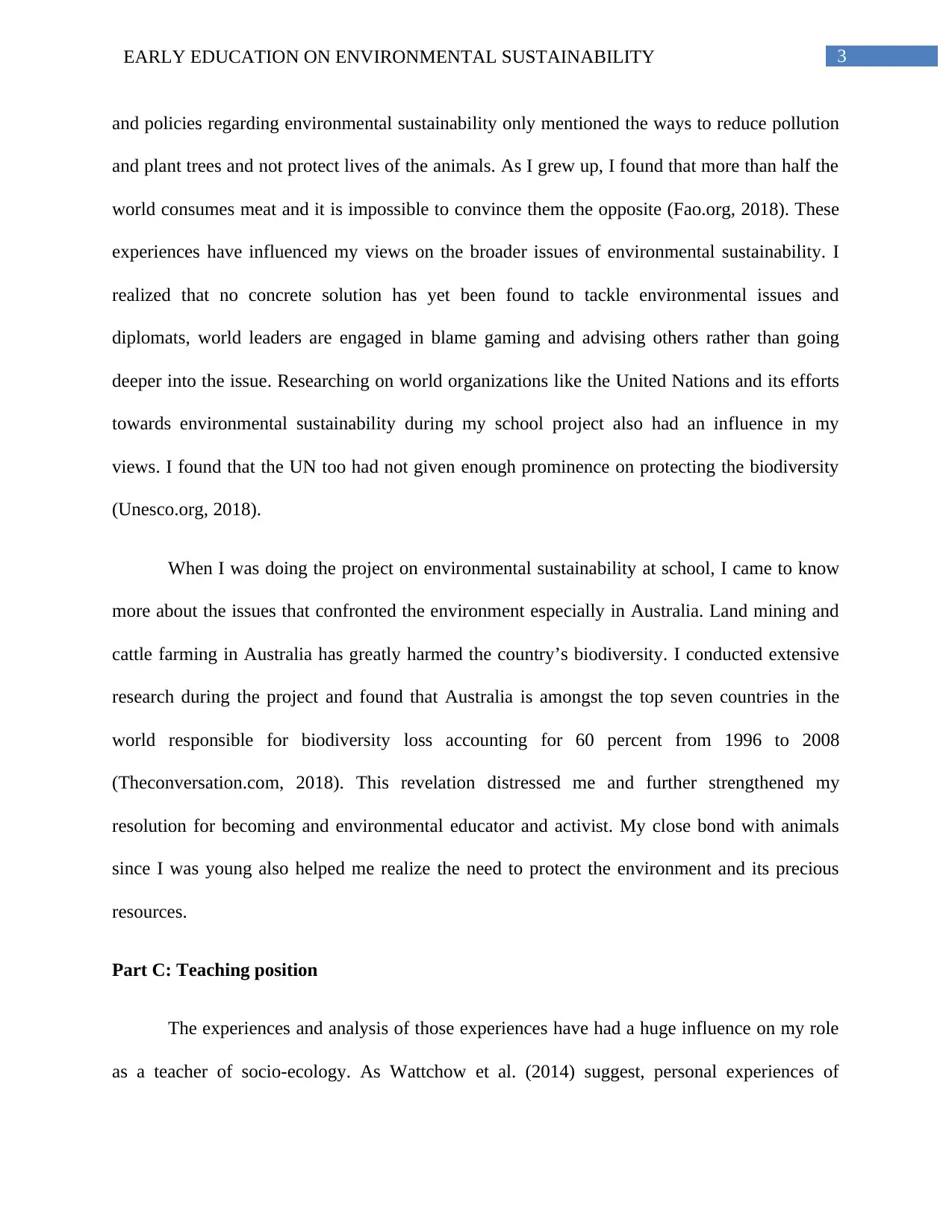
3EARLY EDUCATION ON ENVIRONMENTAL SUSTAINABILITY
and policies regarding environmental sustainability only mentioned the ways to reduce pollution
and plant trees and not protect lives of the animals. As I grew up, I found that more than half the
world consumes meat and it is impossible to convince them the opposite (Fao.org, 2018). These
experiences have influenced my views on the broader issues of environmental sustainability. I
realized that no concrete solution has yet been found to tackle environmental issues and
diplomats, world leaders are engaged in blame gaming and advising others rather than going
deeper into the issue. Researching on world organizations like the United Nations and its efforts
towards environmental sustainability during my school project also had an influence in my
views. I found that the UN too had not given enough prominence on protecting the biodiversity
(Unesco.org, 2018).
When I was doing the project on environmental sustainability at school, I came to know
more about the issues that confronted the environment especially in Australia. Land mining and
cattle farming in Australia has greatly harmed the country’s biodiversity. I conducted extensive
research during the project and found that Australia is amongst the top seven countries in the
world responsible for biodiversity loss accounting for 60 percent from 1996 to 2008
(Theconversation.com, 2018). This revelation distressed me and further strengthened my
resolution for becoming and environmental educator and activist. My close bond with animals
since I was young also helped me realize the need to protect the environment and its precious
resources.
Part C: Teaching position
The experiences and analysis of those experiences have had a huge influence on my role
as a teacher of socio-ecology. As Wattchow et al. (2014) suggest, personal experiences of
and policies regarding environmental sustainability only mentioned the ways to reduce pollution
and plant trees and not protect lives of the animals. As I grew up, I found that more than half the
world consumes meat and it is impossible to convince them the opposite (Fao.org, 2018). These
experiences have influenced my views on the broader issues of environmental sustainability. I
realized that no concrete solution has yet been found to tackle environmental issues and
diplomats, world leaders are engaged in blame gaming and advising others rather than going
deeper into the issue. Researching on world organizations like the United Nations and its efforts
towards environmental sustainability during my school project also had an influence in my
views. I found that the UN too had not given enough prominence on protecting the biodiversity
(Unesco.org, 2018).
When I was doing the project on environmental sustainability at school, I came to know
more about the issues that confronted the environment especially in Australia. Land mining and
cattle farming in Australia has greatly harmed the country’s biodiversity. I conducted extensive
research during the project and found that Australia is amongst the top seven countries in the
world responsible for biodiversity loss accounting for 60 percent from 1996 to 2008
(Theconversation.com, 2018). This revelation distressed me and further strengthened my
resolution for becoming and environmental educator and activist. My close bond with animals
since I was young also helped me realize the need to protect the environment and its precious
resources.
Part C: Teaching position
The experiences and analysis of those experiences have had a huge influence on my role
as a teacher of socio-ecology. As Wattchow et al. (2014) suggest, personal experiences of
Paraphrase This Document
Need a fresh take? Get an instant paraphrase of this document with our AI Paraphraser
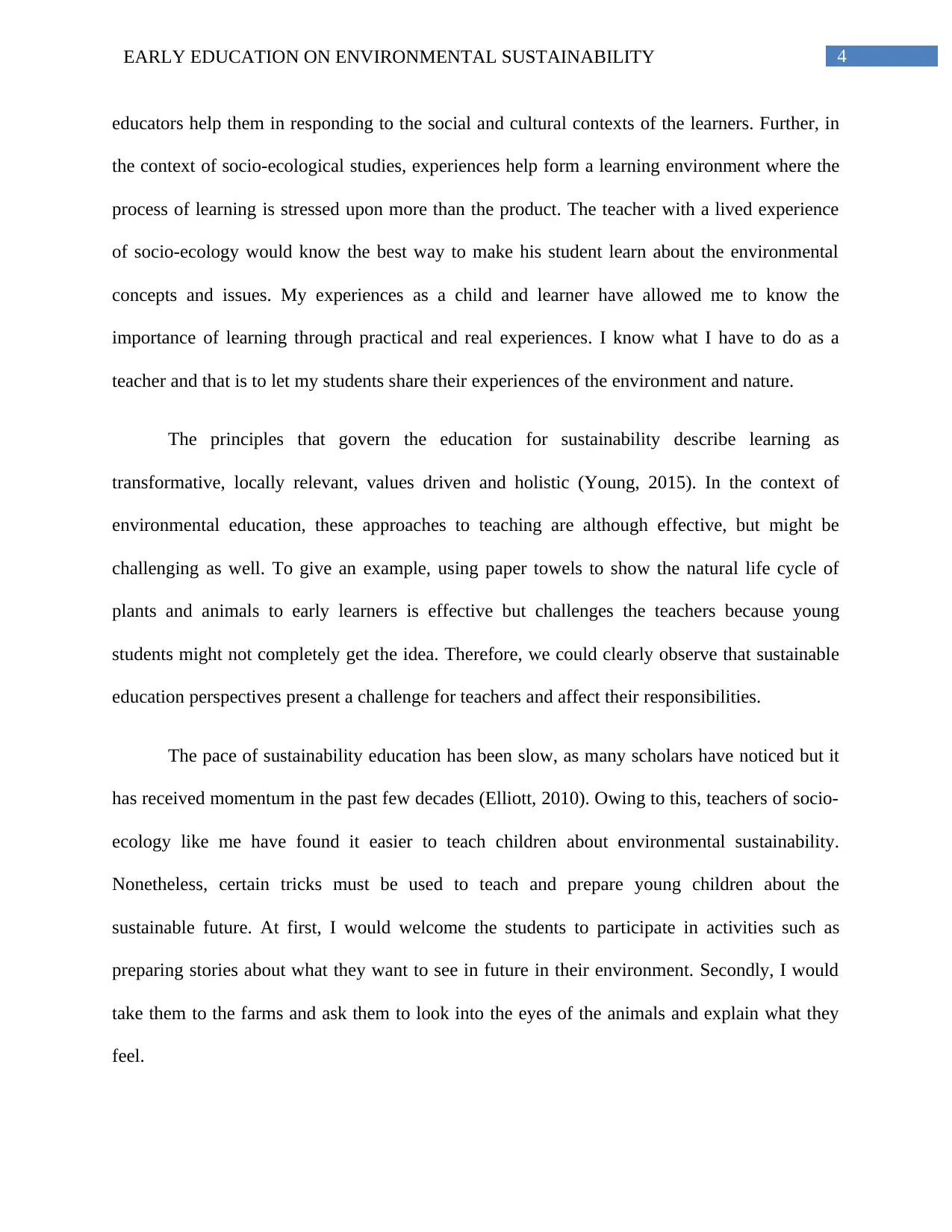
4EARLY EDUCATION ON ENVIRONMENTAL SUSTAINABILITY
educators help them in responding to the social and cultural contexts of the learners. Further, in
the context of socio-ecological studies, experiences help form a learning environment where the
process of learning is stressed upon more than the product. The teacher with a lived experience
of socio-ecology would know the best way to make his student learn about the environmental
concepts and issues. My experiences as a child and learner have allowed me to know the
importance of learning through practical and real experiences. I know what I have to do as a
teacher and that is to let my students share their experiences of the environment and nature.
The principles that govern the education for sustainability describe learning as
transformative, locally relevant, values driven and holistic (Young, 2015). In the context of
environmental education, these approaches to teaching are although effective, but might be
challenging as well. To give an example, using paper towels to show the natural life cycle of
plants and animals to early learners is effective but challenges the teachers because young
students might not completely get the idea. Therefore, we could clearly observe that sustainable
education perspectives present a challenge for teachers and affect their responsibilities.
The pace of sustainability education has been slow, as many scholars have noticed but it
has received momentum in the past few decades (Elliott, 2010). Owing to this, teachers of socio-
ecology like me have found it easier to teach children about environmental sustainability.
Nonetheless, certain tricks must be used to teach and prepare young children about the
sustainable future. At first, I would welcome the students to participate in activities such as
preparing stories about what they want to see in future in their environment. Secondly, I would
take them to the farms and ask them to look into the eyes of the animals and explain what they
feel.
educators help them in responding to the social and cultural contexts of the learners. Further, in
the context of socio-ecological studies, experiences help form a learning environment where the
process of learning is stressed upon more than the product. The teacher with a lived experience
of socio-ecology would know the best way to make his student learn about the environmental
concepts and issues. My experiences as a child and learner have allowed me to know the
importance of learning through practical and real experiences. I know what I have to do as a
teacher and that is to let my students share their experiences of the environment and nature.
The principles that govern the education for sustainability describe learning as
transformative, locally relevant, values driven and holistic (Young, 2015). In the context of
environmental education, these approaches to teaching are although effective, but might be
challenging as well. To give an example, using paper towels to show the natural life cycle of
plants and animals to early learners is effective but challenges the teachers because young
students might not completely get the idea. Therefore, we could clearly observe that sustainable
education perspectives present a challenge for teachers and affect their responsibilities.
The pace of sustainability education has been slow, as many scholars have noticed but it
has received momentum in the past few decades (Elliott, 2010). Owing to this, teachers of socio-
ecology like me have found it easier to teach children about environmental sustainability.
Nonetheless, certain tricks must be used to teach and prepare young children about the
sustainable future. At first, I would welcome the students to participate in activities such as
preparing stories about what they want to see in future in their environment. Secondly, I would
take them to the farms and ask them to look into the eyes of the animals and explain what they
feel.
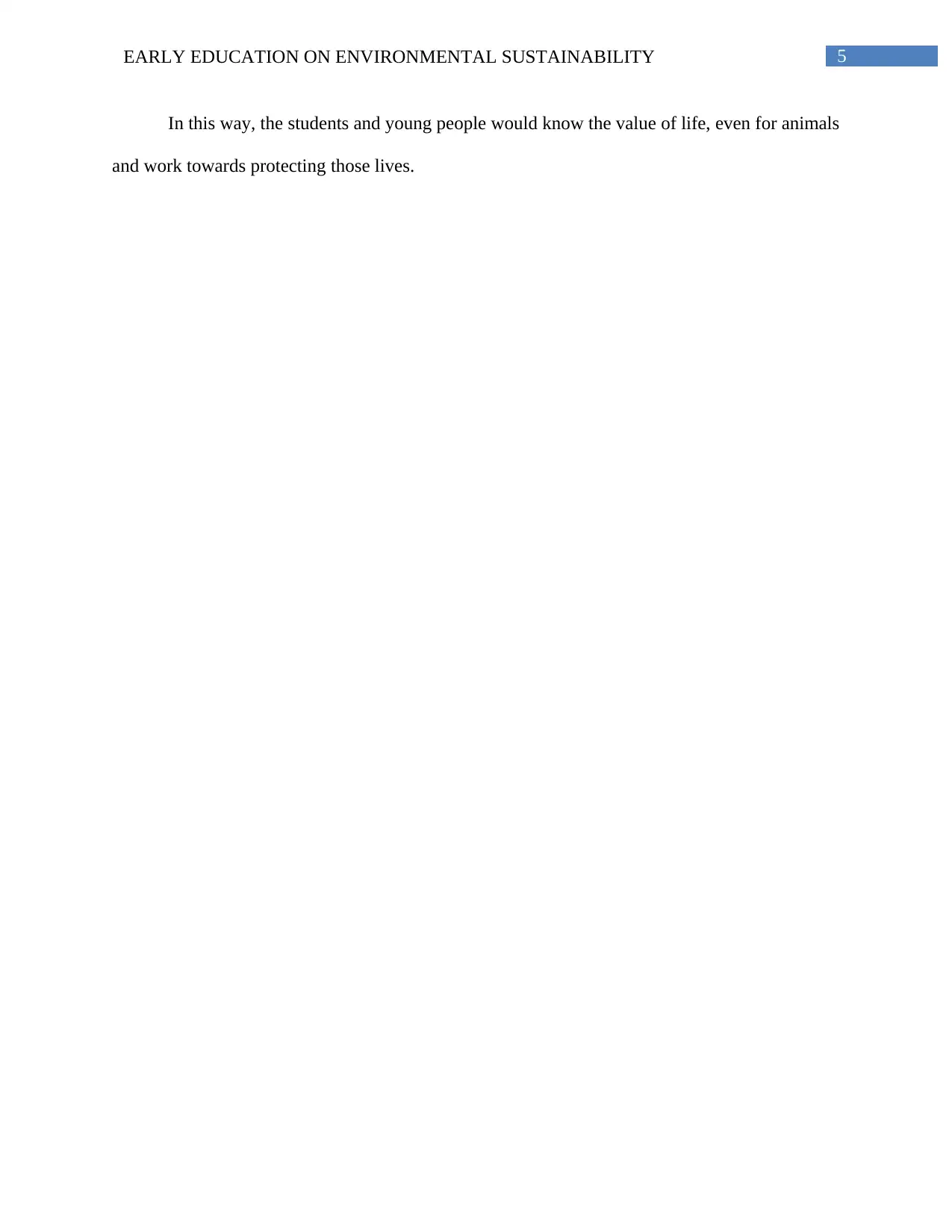
5EARLY EDUCATION ON ENVIRONMENTAL SUSTAINABILITY
In this way, the students and young people would know the value of life, even for animals
and work towards protecting those lives.
In this way, the students and young people would know the value of life, even for animals
and work towards protecting those lives.
⊘ This is a preview!⊘
Do you want full access?
Subscribe today to unlock all pages.

Trusted by 1+ million students worldwide
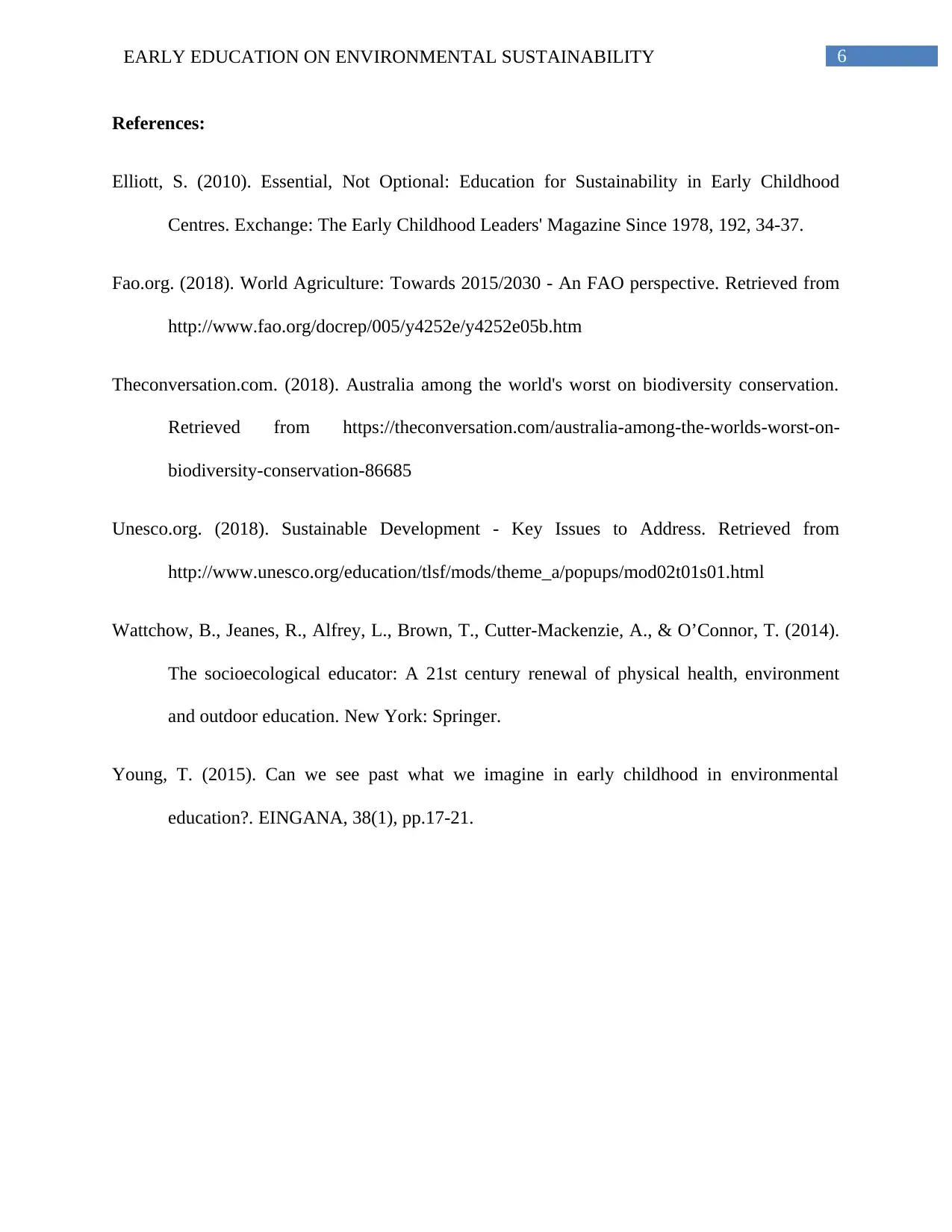
6EARLY EDUCATION ON ENVIRONMENTAL SUSTAINABILITY
References:
Elliott, S. (2010). Essential, Not Optional: Education for Sustainability in Early Childhood
Centres. Exchange: The Early Childhood Leaders' Magazine Since 1978, 192, 34-37.
Fao.org. (2018). World Agriculture: Towards 2015/2030 - An FAO perspective. Retrieved from
http://www.fao.org/docrep/005/y4252e/y4252e05b.htm
Theconversation.com. (2018). Australia among the world's worst on biodiversity conservation.
Retrieved from https://theconversation.com/australia-among-the-worlds-worst-on-
biodiversity-conservation-86685
Unesco.org. (2018). Sustainable Development - Key Issues to Address. Retrieved from
http://www.unesco.org/education/tlsf/mods/theme_a/popups/mod02t01s01.html
Wattchow, B., Jeanes, R., Alfrey, L., Brown, T., Cutter-Mackenzie, A., & O’Connor, T. (2014).
The socioecological educator: A 21st century renewal of physical health, environment
and outdoor education. New York: Springer.
Young, T. (2015). Can we see past what we imagine in early childhood in environmental
education?. EINGANA, 38(1), pp.17-21.
References:
Elliott, S. (2010). Essential, Not Optional: Education for Sustainability in Early Childhood
Centres. Exchange: The Early Childhood Leaders' Magazine Since 1978, 192, 34-37.
Fao.org. (2018). World Agriculture: Towards 2015/2030 - An FAO perspective. Retrieved from
http://www.fao.org/docrep/005/y4252e/y4252e05b.htm
Theconversation.com. (2018). Australia among the world's worst on biodiversity conservation.
Retrieved from https://theconversation.com/australia-among-the-worlds-worst-on-
biodiversity-conservation-86685
Unesco.org. (2018). Sustainable Development - Key Issues to Address. Retrieved from
http://www.unesco.org/education/tlsf/mods/theme_a/popups/mod02t01s01.html
Wattchow, B., Jeanes, R., Alfrey, L., Brown, T., Cutter-Mackenzie, A., & O’Connor, T. (2014).
The socioecological educator: A 21st century renewal of physical health, environment
and outdoor education. New York: Springer.
Young, T. (2015). Can we see past what we imagine in early childhood in environmental
education?. EINGANA, 38(1), pp.17-21.
1 out of 7
Related Documents
Your All-in-One AI-Powered Toolkit for Academic Success.
+13062052269
info@desklib.com
Available 24*7 on WhatsApp / Email
![[object Object]](/_next/static/media/star-bottom.7253800d.svg)
Unlock your academic potential
Copyright © 2020–2025 A2Z Services. All Rights Reserved. Developed and managed by ZUCOL.



